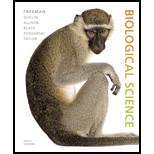
Concept explainers
To review:
The given organization of the signal transduction pathway mediated by scaffold protein affects the speed of the response and amplification of the signal.
Introduction:
Signal transduction is the cellular process involving binding of signaling molecule to a receptor present on cell surface and transmission of signal through the cell triggering a cascade of events inside the cell. Scaffold proteins play essential role in regulating many key signaling pathways by bringing two protein molecules together in close proximity to attain stable configuration through protein–protein interactions. Few intracellular proteins involved in the pheromone-activated response in yeast are organized by a scaffold protein called Ste5. When pheromone binding occurs, one of these proteins, called Fus3 is released from Ste5 and triggers the cellular response.
Want to see the full answer?
Check out a sample textbook solution
Chapter 11 Solutions
Biological Science (6th Edition)
- In response to a hormone secreted by a cell of the opposite mating type, a yeast cell undergoes a complex series of physiological changes involving the activity of about 200 genes and cytoplasmic proteins. They include blockingDNA synthesis, growing toward the mating partner, fusion of the plasma membranes of the two cells, and fusion of their nuclear membranes. Explain how all these events can be controlled through a complex signaling cascade that is triggered by the binding of the hormone to a G protein–linkedreceptor.arrow_forwardWhat type of signal transduction is involved in signaling from hormones such as estrogen and testosterone? Explain the signal transduction pathway that occurs. 1. Is there a short term description for signal transduction, instead wrting multiple words to descripte the type of signal transduction? Can I just identify it as active signal transduction and inactive signal transduction. Based on my understanding, active singal transduction is for the fast react transdcution, while inactive signal transduction meanly refers the hormonal affacts on the system. 2. For Ion channels, specific enzymes are both involed activated and inactivated signal transduction?arrow_forwardExplain how FRET could be used to monitor the association of Gαs and adenylyl cyclase following activation of the epinephrine receptor.arrow_forward
- Describe how ligand binding to a receptor leads to the production of IP3 and DAG and the release of Ca2+.arrow_forwardActivation of certain GPCRs triggers an intracellular signaling mechanism that involves activation of adenlyl cyclase and an increase of cAMP. Which of the following statements best describes the the events that follow such a cAMP increase? a.) The cAMP increase leads to activation of protein kinase C. b.) The cAMP increase leads to activation of the release of the gamma subunit from the GPCR. c.) The cAMP increase leads to activation of protein kinase A.arrow_forwardDescribe three ways in which a gradual increase inan extracellular signal can be sharpened by the target cellto produce an abrupt or nearly all-or-none response.arrow_forward
- Which of the following steps amplify the epinephrine signal response in cells: receptor activation of G protein, G protein activation of adenylyl cyclase, cAMP activation of PKA, or PKA phosphorylation of glycogen phosphorylase kinase (GPK)? Which change will have a greater effect on signal amplification: an increase in the number of epinephrine receptors or an increase in the number of Gαs proteins?arrow_forwardCascading effect occurs when a signal is receive by the receptor ( " turned on" ) but how do cells turns off a signal?arrow_forwardOne of the key components in vertebrate limb development is the polarizing region, also known as the zone or polarizing activituy of ZPA. a) Where in the limb bud is this region? b) What axis of the limb does it help to specify? c) What properties of this region make it an organizing region d) Through which signaling molecule does it exert its effects? e) What is the evidence for the importance of this molecule?arrow_forward
- In a hypothetical cAMP-mediated signal transduction cascade, the GTP-αs/adenylate cyclase interaction following a single hormone–receptor binding event lasts for 2.3 seconds. The catalytic rate (turnover number) for the adenylate cyclase in question is 350 cAMP molecules produced per second. How many cAMP molecules would be produced if five hormone-receptor binding events were to occur before the hormone molecule dissipates in the bloodstream? What is the amplification effect of this step in the signaling pathway?arrow_forwardcompare and contrast the signaling events involved with the second messanger camp and IP3arrow_forwardGive two examples of pheromones except sex pheromones and give an example of insect aside from bees that employ each specific type of pheromone.arrow_forward
 BiochemistryBiochemistryISBN:9781305577206Author:Reginald H. Garrett, Charles M. GrishamPublisher:Cengage Learning
BiochemistryBiochemistryISBN:9781305577206Author:Reginald H. Garrett, Charles M. GrishamPublisher:Cengage Learning Biology (MindTap Course List)BiologyISBN:9781337392938Author:Eldra Solomon, Charles Martin, Diana W. Martin, Linda R. BergPublisher:Cengage Learning
Biology (MindTap Course List)BiologyISBN:9781337392938Author:Eldra Solomon, Charles Martin, Diana W. Martin, Linda R. BergPublisher:Cengage Learning Human Physiology: From Cells to Systems (MindTap ...BiologyISBN:9781285866932Author:Lauralee SherwoodPublisher:Cengage Learning
Human Physiology: From Cells to Systems (MindTap ...BiologyISBN:9781285866932Author:Lauralee SherwoodPublisher:Cengage Learning


